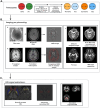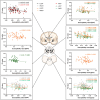Altered Brain Iron Depositions of Spinocerebellar Ataxia Type 3: From Pre-Symptomatic to Symptomatic Stage
- PMID: 40207891
- PMCID: PMC11983486
- DOI: 10.1111/ene.70127
Altered Brain Iron Depositions of Spinocerebellar Ataxia Type 3: From Pre-Symptomatic to Symptomatic Stage
Abstract
Background: Spinocerebellar ataxia type 3 (SCA3) is a rare hereditary neurodegeneration disease. The iron distribution of SCA3 is poorly understood, yet quantitative susceptibility mapping (QSM) has rarely been used in SCA3.
Methods: We prospectively investigated QSM of SCA3 (19 pre-symptomatic and 41 symptomatic) and 37 healthy controls (HCs) recruited from 2018.05 to 2021.01. Group susceptibility was cross-sectionally compared, and the associations between altered brain iron deposition and clinical symptoms, neurofilament light chain (Nfl), and fractional anisotropy of the bilateral corticospinal tracts and cerebellar peduncles were explored. 12 SCA3 participants were followed for at least a year.
Results: Compared to HCs, bilateral SN were observed with significantly increased susceptibility in pre-symptomatic SCA3. Most of the supratentorial nuclei and the right dental nucleus had increased susceptibility in symptomatic than in pre-symptomatic stage and were partially correlated with symptomatic severity, disease duration, and damaged cerebellar peduncles (p < 0.05) but not Nfl (p > 0.05). The left substantia nigra (SN) demonstrated the highest diagnostic efficacy in identifying pre- (AUC = 0.904) and symptomatic SCA3 (AUC = 0.938). The longitudinal study also confirmed the significant change in the left SN (p < 0.01).
Conclusions: Our in vivo QSM evidence demonstrates disease-specific patterns for brain iron depositions in SCA3. Brain iron deposition abnormality is an early event of the SCA3's occurrence and development. The left SN might be a critical site for the disease's start and development.
Keywords: MRI; quantitative susceptibility mapping; spinocerebellar ataxia type 3; substantia nigra.
© 2025 The Author(s). European Journal of Neurology published by John Wiley & Sons Ltd on behalf of European Academy of Neurology.
Conflict of interest statement
The authors declare no conflicts of interest.
Figures




Similar articles
-
Neuromelanin imaging analyses of the substantia nigra in patients with Machado-Joseph disease.Neuroradiology. 2020 Nov;62(11):1433-1439. doi: 10.1007/s00234-020-02479-9. Epub 2020 Jun 18. Neuroradiology. 2020. PMID: 32556403
-
Quantitative susceptibility mapping in spinocerebellar ataxia type 3/Machado-Joseph disease (SCA3/MJD).Acta Radiol. 2020 Apr;61(4):520-527. doi: 10.1177/0284185119868906. Epub 2019 Aug 26. Acta Radiol. 2020. PMID: 31450947 No abstract available.
-
Structural alterations of spinocerebellar ataxias type 3: from pre-symptomatic to symptomatic stage.Eur Radiol. 2023 Apr;33(4):2881-2894. doi: 10.1007/s00330-022-09214-3. Epub 2022 Nov 12. Eur Radiol. 2023. PMID: 36370172
-
No parkinsonism in SCA2 and SCA3 despite severe neurodegeneration of the dopaminergic substantia nigra.Brain. 2015 Nov;138(Pt 11):3316-26. doi: 10.1093/brain/awv255. Epub 2015 Sep 11. Brain. 2015. PMID: 26362908
-
Effectiveness of QSM over R2* in assessment of parkinson's disease - A systematic review.Neurol India. 2020 Mar-Apr;68(2):278-281. doi: 10.4103/0028-3886.284377. Neurol India. 2020. PMID: 32415005
Cited by
-
SCA14-Associated PKCγ-G118D Mutant Exhibits a Detrimental Effect on Cerebellar Purkinje Cell Dendritic Growth.Int J Mol Sci. 2025 Apr 14;26(8):3688. doi: 10.3390/ijms26083688. Int J Mol Sci. 2025. PMID: 40332155 Free PMC article.
References
-
- Seidel K., Siswanto S., Brunt E. R. P., den Dunnen W., Korf H.‐W., and Rüb U., “Brain Pathology of Spinocerebellar Ataxias,” Acta Neuropathologica 124 (2012): 1–21. - PubMed
-
- Koeppen A. H., “The Neuropathology of Spinocerebellar Ataxia Type 3/Machado‐Joseph Disease,” in Polyglutamine Disorders, ed. Nóbrega C. and Pereira de Almeida L. (Springer International Publishing, 2018), 233–241.
MeSH terms
Substances
Grants and funding
- 2024A151501094/Guangdong Basic and Applied Basic Research Foundation
- 82172015/National Natural Science Foundation of China
- 82402232/National Natural Science Foundation of China
- 2022A1515011264/Guangdong Basic and Applied Basic Research Foundation
- 2024A1515030233/Guangdong Basic and Applied Basic Research Foundation
LinkOut - more resources
Full Text Sources
Medical

